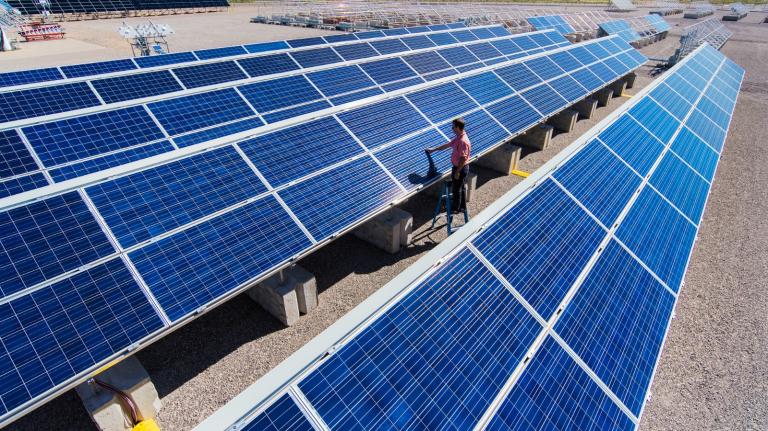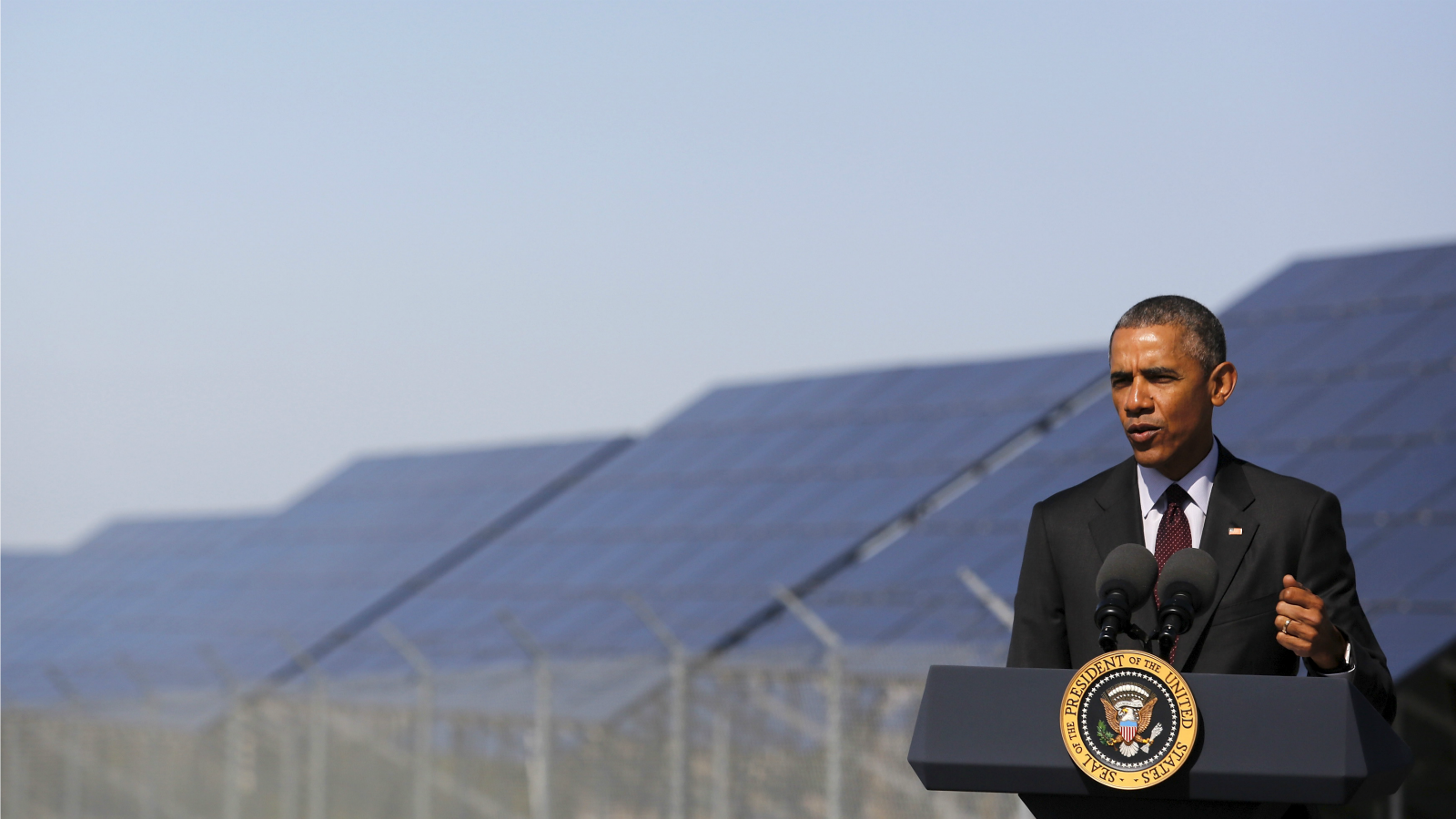This story was originally published by High Country News and is reproduced here as part of the Climate Desk collaboration.
Eight years ago, President-elect Barack Obama wanted Colorado Sen. Ken Salazar to be his Interior secretary. David Hayes, who was leading Obama’s transition team for Interior and other agencies, remembers trekking to Salazar’s office on Capitol Hill at least twice to make the case for the Cabinet post.
He had the perfect bait. Three years earlier, Sen. Salazar had led a successful effort to require the Bureau of Land Management to authorize renewable energy projects on public land. The agency was supposed to approve 10,000 megawatts of solar, wind, and geothermal electricity by 2015, but under then-President George W. Bush, its congressional mandate went nowhere. Hayes, seeing a rare opportunity, told Salazar that as Interior secretary, he’d have the chance to make renewables on public land a signature issue.
“We talked about renewable energy and how the Interior Department could turbo-charge potential renewable energy on public lands and make up for the historic and long-standing failure to give renewable energy anything like the attention fossil fuels had gotten on public lands,” Hayes recalled in a recent interview.
Salazar took the job, and made clean energy projects on public land a top priority. The initiative took the department from zero to 60 on renewables, and it is a clear example of the paradigm shift that the Obama administration brought to the West and to its energy development.
Eight years later, a new president-elect has dismissed climate change as a hoax, promised to revive coal and other extractive industries, and sworn to cut — or gut — the U.S. Environmental Protection Agency. Come Jan. 20, 2017, many of Obama’s initiatives will be under sustained attack. Some of them won’t survive. But Obama helped transform the West’s view of its energy potential, and he encouraged the region to get involved in the global fight against climate change. Changes like that go deep and may prove harder to undo.
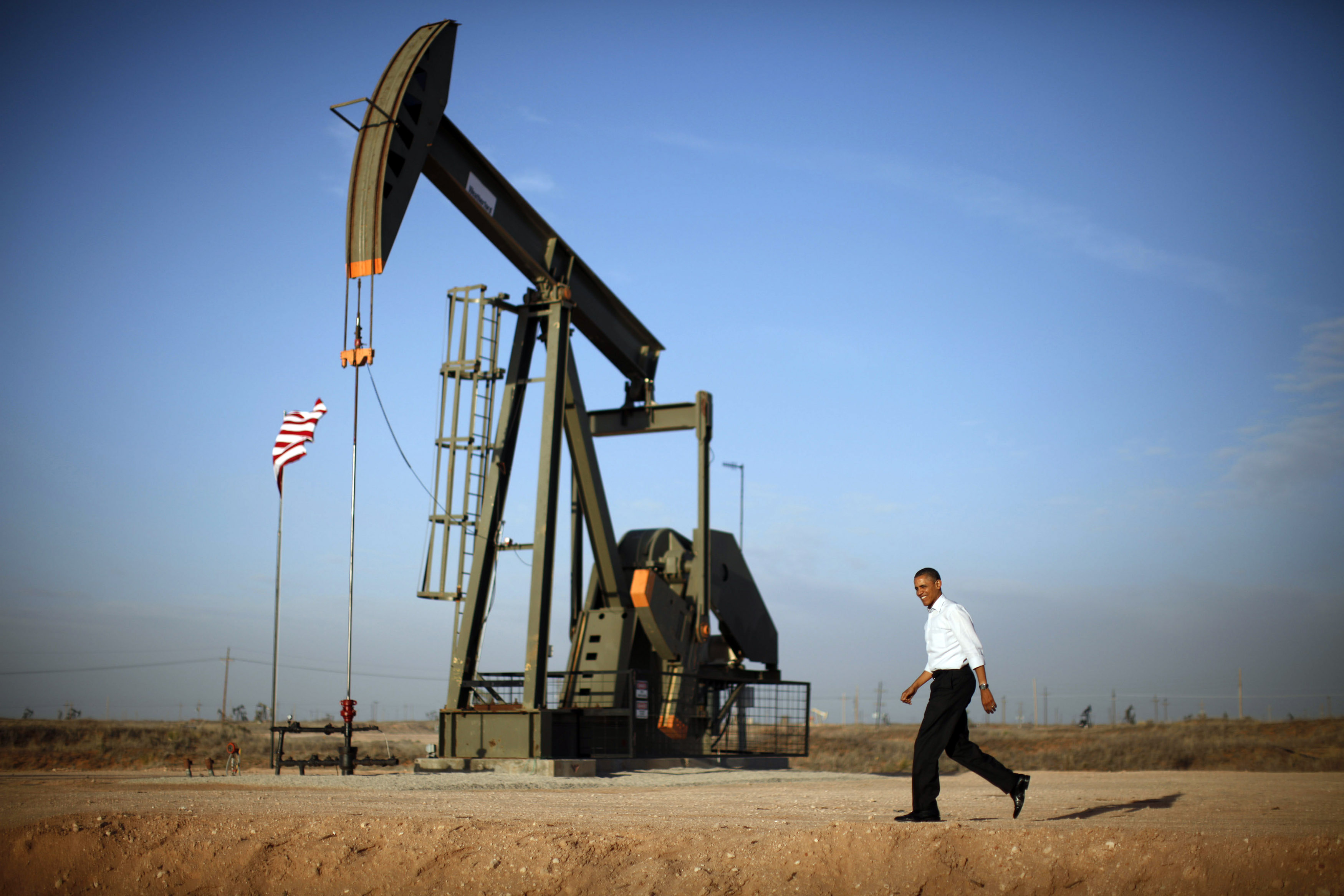
U.S. President Barack Obama walks past a pumpjack on his way to deliver remarks on energy independence at Maljamar Cooperative Association Unit in New Mexico, March 21, 2012. REUTERS/Jason Reed
Climate change
The president’s work on climate change started slowly. During his first term, Obama spent most of his political capital on the Affordable Care Act and his economic recovery plan to lift the nation out of recession. Following his reelection, however, he focused broadly on domestic energy production and later the growing threat of climate change.
In early 2012, Obama traveled to Boulder City, Nevada, to stand in the midst of a sea of photovoltaic panels at what was at the time the largest facility of its kind in the country. “I want everybody here to know that as long as I’m president, we will not walk away from the promise of clean energy,” he told the crowd. But he also underscored his commitment to drilling. “We are going to continue producing oil and gas at a record pace. That’s got to be part of what we do. We need energy to grow.”
In his 17-minute speech, which was entirely about energy, Obama did not use the term “climate change” once, signaling an administration-wide retreat that continued for many months. Congressional Republicans, some of whom deny that climate change is a threat and others who reject attempts to deal with it as economically risky, kept attacking. Meanwhile, activists grew impatient.
In February 2013, 48 climate scientists and activists were arrested after some of them cuffed themselves to the White House gate, determined to force Obama to make potentially politically perilous decisions to fight global warming, such as rejecting the proposed Keystone XL pipeline. Sierra Club Executive Director Michael Brune, who was among them, told me before the demonstration that their civil disobedience signaled “a new level of urgency regarding climate change, and a growing impatience about the lack of political courage that we’re seeing from the president and from leaders in Congress.” The demonstration also marked a major shift for some mainstream environmental groups, who began prodding the president more and cheering him less. This period also saw the rise of brasher environmental groups like 350.org and WildEarth Guardians, who staged large public demonstrations or tackled the president in the courts.
In response, Obama came out with his Climate Action Plan in June 2013. It outlined a sweeping agenda to use his executive powers to slash greenhouse gas emissions from power plants, reduce methane emissions from oil and gas production, and cut the federal government’s carbon pollution. It also recommended preparing communities for bigger storms, rising seas, and fiercer wildfires, and it called for better climate science. In January 2014, Obama recruited John Podesta, former chief of staff for President Bill Clinton, to implement the plan. Soon, the administration was ticking off successes.
In his final years in office, Obama has produced a powerful National Climate Change Assessment, preserved vast stretches of land as national monuments, won court battles over its clean car rules and the EPA’s right to regulate carbon pollution from power plants, drafted regulations to slash greenhouse gases, and negotiated major bilateral treaties with China, India, and Brazil, as well as the historic Paris climate agreement with nearly every nation on the planet. What had started slowly was picking up steam.
Under Obama, the Interior Department started examining climate impacts across broad landscapes, combining the forces of various state and federal agencies and universities. The department set up and staffed 22 landscape conservation cooperatives across the country and eight regional climate centers. The National Park Service, which had no climate change program before Obama, has completed climate impact assessments on 235 of 413 of the nation’s parks — documenting intensified wildfires, hastened snowmelt, vanishing glaciers, rising sea and lake levels, warming streams, and displaced plants and animals.
All told, Obama has elevated climate change’s importance for federal land and water managers and invigorated state and local action.
“It’s a gargantuan legacy,” says Douglas Brinkley, a historian at Rice University. “I put him as one of the top environmental presidents in history. He’s not Theodore or Franklin Roosevelt. But he’s in that league with Lyndon Johnson, J.F. Kennedy, and Richard Nixon.” Climate change is shaping up to be a major issue for Obama’s post-presidential life. “It’s become personal to him. His wife and daughters have helped him reach this conclusion.”
Obama himself underscored his dedication on a trip to Yosemite National Park in June with the First Lady and their daughters. “When we look to the next century, the next 100 years, the task of protecting our sacred spaces is even more important,” he told some 200 invited guests, against the stunning backdrop of Upper and Lower Yosemite Falls. “And the biggest challenge we’re going to face, in protecting this place and places like it, is climate change. Make no mistake: Climate change is no longer just a threat; it’s already a reality.”
Renewables
Throughout the West, climate change has exacerbated forest fires, threatened water supplies, flooded communities, killed millions of trees, and irreversibly altered the landscape. As these consequences have become clearer, the Obama administration has helped steer the West toward a cleaner energy future.
Eight years after Salazar became Interior secretary, the BLM has approved plans for 15,000 megawatts of renewable power, enough to power millions of homes. Projects providing up to 5,500 megawatts’ worth of power are already built or under construction, mostly in California and Nevada.
By establishing a system for approving renewable energy projects on public lands, the Obama administration helped drive phenomenal growth in renewable electricity in the West and a precipitous drop in prices. “I think it is an unsung part of the administration’s legacy, and I think the administration can and should be taking credit for really creating the conditions for this huge clean energy revolution to take off,” says Rhea Suh, who was assistant secretary of Interior for policy management and budget until she became president of the Natural Resources Defense Council last year.
After Congress passed the Energy Policy Act of 2005, Ray Brady was tapped to be the BLM’s manager for implementing the law. With targets for renewable energy 10 years in the future, nothing much happened. The top staff at the agency gave the new program little notice. Expediting oil and gas production was their chief focus. The agency didn’t even open a renewable energy office. That all changed when Salazar walked in the door.
In his first secretarial order, in March 2009, Salazar moved up the deadline for permitting 10,000 megawatts of clean power on BLM lands three years, to 2012. “We have to connect the sun of the deserts and the wind of the plains with the places where people live,” Salazar said at the time. He pushed his staff to identify specific zones on U.S. public lands suitable for large-scale production of solar, wind, geothermal, and biomass energy.
This was a revolutionary vision at the time; there weren’t any large-scale solar plants anywhere in the United States. Brady had to travel to Spain in 2008 just to glimpse the technology. For decades, Brady had been an obscure bureaucrat, but suddenly he found himself regularly summoned to high-level meetings with Salazar and other Interior leaders. Meanwhile, Salazar met regularly with other Cabinet members — including the secretaries of Defense, Agriculture, and the Treasury — to knock down barriers to nascent projects.
The timing was right: Obama had campaigned, twice, on the promise of clean energy and its ability to create good jobs for the future. And there was a growing market for renewable power, because many Western states had passed renewable energy requirements, while California was pursuing one of the world’s most aggressive commitments to greenhouse gas reduction.
The enormity of the endeavor really struck Brady when he first visited the Ivanpah Solar Generating System project in San Bernardino County, California, in 2012: Three shining towers, emerging from the desolate desert, each surrounded by a huge circular field of mirrors, 173,500 of them, and covering 3,500 acres of BLM land. (Critics say such facilities endanger birds and other wildlife, but the project stands as a monument to the shifting attitudes toward energy on public lands.)
For much of his career, Brady worked on oil and gas, where drilling pads covered a single acre. “It’s awe-inspiring,” said Brady, who recently retired from the BLM. “I was absolutely amazed by the scope and scale and size of the project. It had not sunk into me before that. It really was, in my mind, the most exciting period in my 40-year career.”
While nudging individual projects forward, the agency’s new renewable energy office worked to track down Western locations suited to solar power. They looked for easy access to transmission lines and big metropolitan areas, lack of conflicts with local tribes, and few risks to endangered wildlife and plants or other fragile natural resources. In these so-called solar energy zones, the agency conducts the environmental analysis up-front, to reduce permitting times. The BLM held its first-ever competitive auction for solar projects in the summer of 2014. Three companies won bids, and one recently started construction in Dry Lake, Nevada, north of Las Vegas.
Interior was much less successful at establishing wind power on public land. The Chokecherry and Sierra Madre wind project in south-central Wyoming, for example, has been a priority since Salazar took the helm at Interior. The enormous project would erect up to 1,000 wind turbines, employing as many as 1,000 people during peak construction, and eventually provide clean electricity to about a million homes. The BLM gave it basic approval in 2012, but many more permitting requirements remained. “To put it bluntly, they lost momentum,” says Bill Miller, president of two subsidiaries of the Anschutz Power Company of Wyoming and TransWest Express. Miller still believes in the project despite the delays. He told me: “There is no better wind asset in the country.” And he’s optimistic that he’ll get final approval before Obama leaves office to erect the first 500 turbines.
With plenty of windy places on private land, wind developers may simply ignore public land. But both geothermal and solar projects have a bright future, even under a Donald Trump administration. The price of photovoltaic solar systems continues to drop, making public land attractive for small and mid-sized projects, especially in areas where the agency has done the upfront work, so developers can get relatively quick approval. This fall, the administration and California state government completed the Desert Renewable Energy Conservation Plan, which charts a course for developing clean power across 22 million acres of desert. In November, the administration finished the regulations that will govern competitive leasing for renewable power projects on public land.
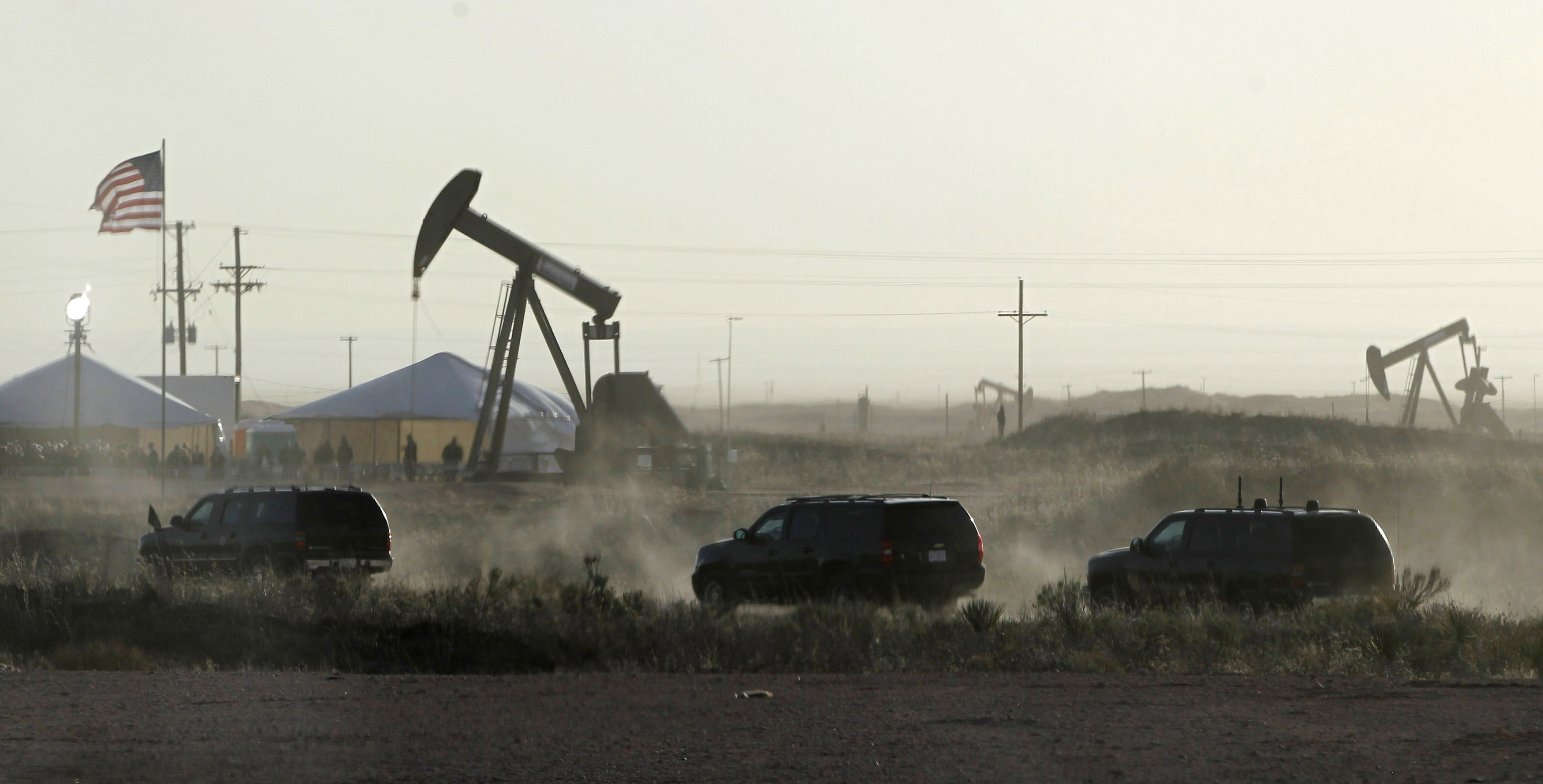
U.S. President Barack Obama’s SUV arrives at Maljamar Cooperative Association Unit in the New Mexico desert, March 21, 2012. REUTERS/Jason Reed
Extractives
Still, when it comes to fossil fuels, the administration’s record remains mixed as far as what it did, and didn’t do, for the climate. Obama curtailed fossil fuel pollution but failed to significantly limit industry’s access to the public’s vast fossil fuel resources. Even while promoting renewable energy, the White House simultaneously supported an expansion of oil and gas drilling. Shale gas production grew fourfold from 2009 to 2015, oil production nearly doubled, and oil exports tripled.
On the regulatory side, though, the EPA set new rules to reduce leakage of methane, a potent greenhouse gas, from new oil and gas drilling. Near the end of the administration, the BLM went even further, setting new requirements to reduce methane leaks from existing oil and gas operations on public land.
Obama was slow to apply his climate change principles to fossil fuels beneath federal land. Throughout his administration, the Interior Department continued to lease federal lands for oil and gas development and fought in court against environmentalists’ “keep it in the ground” campaign.
Coal, long the mainstay of U.S. electricity production, declined dramatically during Obama’s tenure, a fact that helped the nation reduce its greenhouse gas emissions. This was primarily due to competition from abundant, low-price natural gas, caused by the boom in hydraulic fracturing. But Obama’s air pollution policies played a role, too. By setting the first-ever limits for mercury and other toxic air pollutants, Obama forced companies to decide whether it was cheaper to install expensive pollution-control devices or switch to natural gas or renewables. “What the Obama administration rules did was force utilities to consider the question about whether or not to keep coal online,” the Sierra Club’s Brune explained.
But most of this progress was the result of the EPA’s work. It was only in the final 18 months of Obama’s term that Sally Jewell, who replaced Salazar as Interior secretary, started scrutinizing the department’s coal policies. She held listening sessions in coal country and in Washington, D.C. In January, she set a moratorium on new coal leasing and ordered the first-ever analysis of greenhouse gas impacts from federal coal, which accounts for more than 40 percent of the coal used to produce electricity in the U.S. In Obama’s last State of the Union address, in January, he declared that it was time to revamp the way the country manages its coal and oil, “so that they better reflect the costs they impose on taxpayers and the planet.”
Despite this, the administration pulled its punches on federal coal until its final days. Most notable was its decision to support Colorado’s plan to allow expansion of coal mining into otherwise roadless national forest areas in the North Fork Valley (where High Country News is headquartered).
In 2014, a federal judge halted an expansion of Colorado’s West Elk Mine because the BLM and Forest Service had failed to take a “hard look” at the climate impacts that an exemption to the roadless rule would create. Environmental groups had sued, demanding that the BLM and Forest Service calculate the costs to society of greenhouse gas emissions from the mining and combustion of that federal coal.
In November, the Forest Service released an environmental impact statement that revealed that its preferred alternative could increase greenhouse gas emissions 433 million tons over time and cost society billions of dollars. Yet it continued to insist that the expansion should take place.
The pollution would come from burning the coal for electricity and from venting methane into the air during mining. Methane is high at West Elk because the coal seams are especially gassy.
Robert Bonnie, undersecretary of Agriculture for natural resources and the environment, justified the decision. “No one is under the belief that we’re going to immediately change the energy mix starting today,” he said. “There’s going to be some level of coal for some time to come.”
But Earthjustice attorney Ted Zukoski sees a deep hypocrisy in the decision. “There is a conflict between this administration’s soaring and bold rhetoric on the need to address climate change and its failure to keep fossil fuels in the ground,” he says. “Billions of tons of federal coal were leased on Obama’s watch.”
As for natural gas and oil, the administration purposefully avoided regulations that would slow the upsurge in production. “This administration was not willing or able to take on two fossil fuel industries at the same time,” Brune told me. “And it proactively took many steps to help support the gas industry. We’re going to be wrestling with the effects of that for decades. An increased reliance on natural gas is a disaster for our climate.”
What will remain?
During most of his administration, Obama faced Republicans in Congress who simply refused to legislate. In response, Obama turned to executive action. Now, however, Trump’s win endangers much of the progress he made. Trump has vowed to abandon the Paris climate treaty and cancel the Clean Power Plan. Although the specifics remain unclear, many of Obama’s other climate policies, such as his methane rules, are also at risk. But some important changes may escape Trump’s chopping block. The administration and its policies don’t stand alone, so they can have lasting impact. Obama’s energy and climate change policies augmented on-the-ground realities, such as many Western states’ eagerness to embrace renewable energy and the improving economics of solar power. “They helped facilitate it,” said Mark Squillace, law professor at the University of Colorado at Boulder. “But the story of the West will be about what the states are doing.”
In the Southwest, for example, local, state, and federal government officials, scientists, and businesses have long worried about the impacts of climate change on water supply, fragile species, and wildfire. Obama’s conservation cooperatives and regional climate centers filled a void. “Everybody knew these things were happening,” said Jonathan Overpeck, director of the University of Arizona’s Institute of the Environment. “Now we have a mandate for research and figuring out what can we do about it. We’re trying to not just generate scientific knowledge for the sake of curiosity, but to make sure we’re generating science that’s useful.”
Hayes, meanwhile, who had been tapped for a big role in a Clinton transition, was flabbergasted by the election results. He hopes the Interior Department’s commitment to climate science will survive the new administration.
Even if research continues, many of Obama’s fossil fuel regulations surely will be targeted by Trump’s administration. The new EPA chief and Interior secretary could settle industry lawsuits by asking courts to send Obama’s rules — including the Clean Power Plan, methane rules, and BLM’s fracking regulations — back to agencies to rewrite them. Environmental groups would then likely sue to block Trump’s new rules and reinstate Obama’s, and the ensuing legal battles could take years.
“If Trump gets only one term and is replaced by a Democrat, damage will be significant but also limited,” Squillace said. “I think if Trump gets two terms, all bets are off and significant change in public lands and environmental policy will occur.”
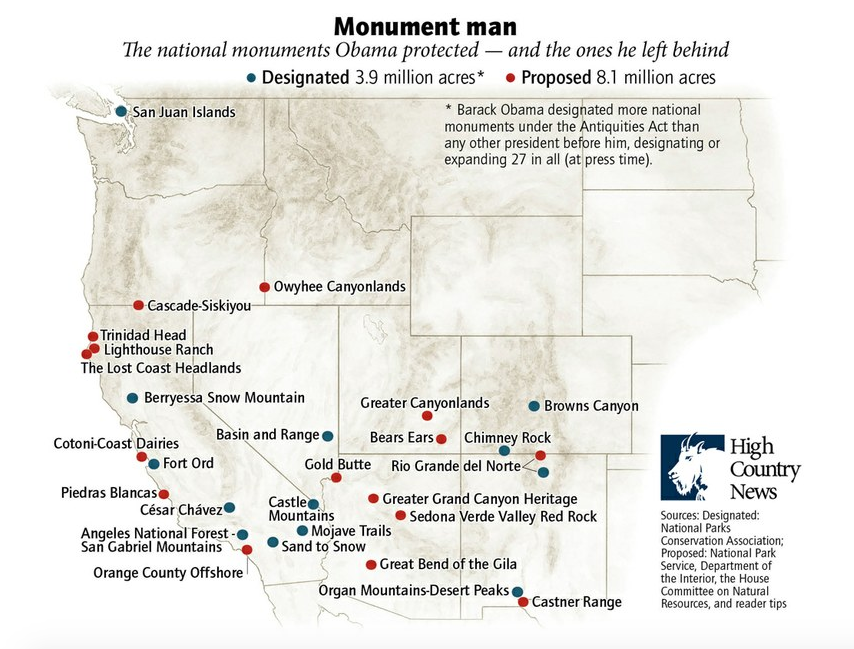
Another danger is a possible government “brain drain.” Squillace, for example, was a young lawyer at the Interior Department when President Ronald Reagan appointed Interior Secretary James Watt, who was hostile to conservation. Squillace remembers asking to be taken off one case after another, because he considered Watt’s positions indefensible. After nine months of this, he resigned. Trump may inspire a similar exodus of scientists and lawyers.
Regardless, some of Obama’s climate policies likely will withstand at least the early years of a Trump administration, particularly the BLM’s renewable energy program. If Trump kills the Clean Power Plan, that would take away one driver for big solar projects on public land. But others won’t disappear, most significantly, California Gov. Jerry Brown’s directive that his state gets 50 percent of its power from renewable sources by 2030.
Steve Black, who was Salazar’s counselor at Interior and now is an energy and climate policy consultant based in California, sees other reasons for optimism. More than 100 full-time, career BLM staffers work in renewable energy offices across the West that didn’t exist before Obama. Massive projects like Ivanpah will keep delivering clean power to the grid. “There’s steel in the ground,” he said. “We built 15 utility-scale projects. Those things can’t be changed. I do think there are lasting elements of this legacy.”
Despite Trump’s cheerleading for coal, the new administration is unlikely to rescue the dirtiest fossil fuel. Market forces, namely low natural gas prices, are the main reason for its downturn, but the growing international desire to combat climate change is another. Trump similarly is unlikely to boost oil and gas production, as long as prices are low. For instance, Trump and a Republican Congress may open the Arctic Wildlife Refuge to oil companies, but high costs could deter drilling.
And even with a president and Congress unwilling to tackle tough questions on energy and the climate, states will remain largely responsible for their own energy choices. Even with big utilities fighting hard against solar, low renewable energy prices and state mandates will make the clean energy revolution hard to stop. It’s unlikely that Trump will want to be responsible for killing the good jobs that renewable energy is creating. For all its starts and stops, the Obama administration helped the West embrace a clean energy future that takes climate change into consideration. Trump’s administration won’t be able to change that.
